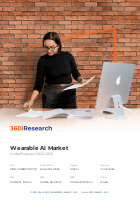
Wearable AI Market by Product Type (Fitness Bands, Smart Glasses, Smart Patches), Component (Hardware, Software), Connectivity, Application, Distribution Channel, Deployment, End Users - Global Forecast 2025-2030
SKU
MRR-C002B1C997D1
Region
Global
Publication Date
December 2025
Delivery
Immediate
2024
USD 32.51 billion
2025
USD 36.38 billion
2030
USD 65.80 billion
CAGR
12.46%

Download a Free PDF
Get a sneak peek into the valuable insights and in-depth analysis featured in our comprehensive wearable ai market report. Download now to stay ahead in the industry! Need more tailored information? Ketan is here to help you find exactly what you need.



